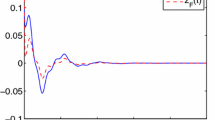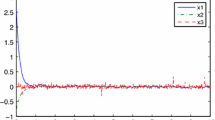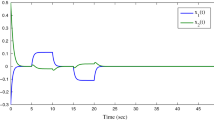Abstract
In this paper, l ∞ fuzzy filtering problem is dealt for nonlinear systems with both persistent bounded disturbances and missing probabilistic sensor information. The Takagi–Sugeno (T–S) fuzzy model is adopted to represent a nonlinear dynamic system. The measurement output is assumed to contain randomly missing data, which is modeled by a Bernoulli distributed with a known conditional probability. To design the l ∞ fuzzy filter and guarantee tracking performance, the effect of the perturbation against persistent bounded disturbances is reduced by using the minimum l ∞ performance. By using the fuzzy basis-dependent Lyapunov function approach, a sufficient condition is established that ensure the mean square exponential stability of the filtering error. The proposed sufficient condition is represented as some linear matrix inequalities (LMIs), and the filter gain is obtained by the solution to a set of LMIs. Finally, the effectiveness of the proposed design method is shown via an example.
Similar content being viewed by others
References
U. Shaked and N. Berman, “H ∞ nonlinear filtering of discrete-time process,” IEEE Trans. Signal Proces., vol. 43, no. 9, pp. 2205–2209, 1995.
M. Vidyasagar, “Optimal rejection of persistent bounded disturbances,” IEEE Trans. Autom. Control, vol. 32, no. 6, pp. 527–534, 1986.
M. Vidyasagar, “Further results on the optimal rejection of persistent bounded disturbances,” IEEE Trans. Autom. Control, vol. 36, no. 6, pp. 642–652, 1991.
D. O. Brian Anderson, and J. B. Moore, Optimal Filtering, Dover Publications, Inc., 1979.
L. Chisci, J. A. Rossiter, and G. Zappa, “Systems with persistent disturbances: Predictive control with restricted constraints,” Automatica, vol. 37, no. 7, pp. 1019–1028, 2001.
J. S. Shamma, “Nonlinear state-feedback for l ∞ optimal control,” Syst. Control Lett., vol. 21, pp. 264–270, 1993.
J. S. Shamma and M. A. Dahleh, “Time-varying versus time-invariant compensation for rejection of persistent bounded disturbances and robust stabilization,” IEEE Trans. Autom. Control, vol. 36, no. 7, pp. 838–847, 1991.
C. T. Lin and C. F. Juang, “An adaptive neural fuzzy filter and its applications,” IEEE Trans. Syst. Man, Cybern. Part B, vol. 27, no. 4, pp. 635–656, 1997.
C. S. Tseng, “Robust fuzzy filter design for nonlinear systems with persistent bounded disturbances,” IEEE Trans. Syst. Man, Cybern. Part B, vol. 36, no. 4, pp. 940–945, 2006.
D. H. Lee and Y. H. Joo, “Extended robust H 2 and H ∞ filter design for discrete-time invariant linear systems,” Circuits Syst. Signal Proces., vol. 33, no. 2, pp. 393–419, 2014.
D. H. Lee, Y. H. Joo, and M. H. Tak, “Periodically timevarying H ∞ memory filter design for discrete-time LTI systems with polytopic uncertainty,” IEEE Trans. Autom. Control, vol. 59, no. 5, pp. 1380–1385, 2014.
D. C. W. Ramos and P. L. D. Peres, “An LMI condition for the robust stability of uncertain continuous-time linear systems,” IEEE Trans. Autom. Control, vol. 47, no. 4, pp. 675–678, 2002.
Z. Wang, F. Yang, D.W. C. Ho, and X. Liu, “Robust H ∞ filtering for stochastic time-delay systems with missing measurements,” IEEE Trans. Signal Proces., vol. 54, no. 7, pp. 594–599, 2006.
H. Gao, Y. Zhao, J. Lam, and K. Chen, “H ∞ fuzzy filtering of nonlinear systems with intermittent measurements,” IEEE Trans. Fuzzy Syst., vol. 17, no. 2, pp. 291–300, 2009.
D. H. Lee, Y. H. Joo, and M. H. Tak, “Linear matrix inequality approach to local stability analysis of discretetime Takagi–Sugeno fuzzy systems,” IET Control Theory Appl., vol. 7, no. 9, pp. 1309–1318, 2013.
D. H. Lee, Y. H. Joo, and M. H. Tak, “Local stability analysis of continuous-time Takagi–Sugeno fuzzy systems: A fuzzy Lyapunov function approach,” Inf. Sci., vol. 257, no. 1, pp. 163–175, 2014.
D. H. Lee and Y. H. Joo, “On the generalized local stability and local stabilization conditions for discrete-time Takagi–Sugeno fuzzy systems,” IEEE Trans. Fuzzy Syst., vol. 22, no. 6, pp. 1654–1668, 2014.
D. H. Lee, J. B. Park, and Y. H. Joo, “Approaches to extended non-quadratic stability and stabilization conditions for discrete-time Takagi–Sugeno fuzzy systems,” Automatica, vol. 47, no. 3, pp. 534–538, 2011.
G. B. Koo, J. B. Park, and Y. H. Joo, “Intelligent digital redesign for nonlinear systems using a guaranteed cost control method,” Int. J. Control, Autom. Syst., vol. 11, no. 6, pp. 1075–1083, 2013.
H. C. Sung, J. B. Park, and Y. H. Joo, “Observer-based sampled-data control for nonlinear systems: Robust intelligent digital redesign approach,” Int. J. Control, Autom. Syst., vol. 12, no. 4, pp. 486–496, 2014.
M. K. Song, J. B. Park, and Y. H. Joo, “Stability and stabilization for discrete-time Markovian jump fuzzy systems with time-varying delays: Partially known transition probabilities case,” Int. J. Control, Autom. Syst., vol. 11, no. 1, pp. 136–146, 2013.
J. B. Burl, “H ∞ estimation for nonlinear systems,” IEEE Trans. Signal Proces. Lett., vol. 5, no. 8, pp. 199–202, 1998.
B. S. Chen, C. L. Tsai, and Y. F. Chen, “Mixed H 2/H ∞ fil-tering design in multirate trans-multiplexer systems: LMI approach,” IEEE Trans. Signal Proces., vol. 49, no. 11, pp. 2693–2701, 2001.
W. Zhang, B. S. Chen, and C. S. Tseng, “H ∞ robust filter-ing for nonlinear stochastic systems,” IEEE Trans. Signal Proces., vol. 53, no. 2, pp. 589–598, 2005.
C. S. Tseng, “Robust fuzzy filter design for a class of non-linear stochastic systems,” IEEE Trans. Fuzzy Syst., vol. 15, no. 2, pp. 261–274, 2007.
C. Weber and J. Allebach, “Convolution and Hankel opera-tor norms for linear systems,” IEEE Trans. Autom. Control, vol. 34, no. 1, pp. 94–98, 1989.
H. J. Lee, J. B. Park, and G. Chen, “Robust fuzzy control of nonlinear systems with parametric uncertainties,” IEEE Trans. Fuzzy Syst., vol. 9, no. 2, pp. 369–379, 2001.
Z. Wang, D. W. C. Ho, and X. Liu, “Variance-constrained filtering for uncertain stochastic systems with missing mea-surements,” IEEE Trans. Autom. Control, vol. 48, no. 7, pp. 1254–1258, 2003.
Z. Wang, D. W. C. Ho, and X. Liu, “Variance-constrained control for uncertain stochastic systems with missing mea-surements,” IEEE Trans. Syst. Man, Cybern. Part A, vol. 35, no. 5, pp. 746–753, 2005.
B. Sinopoli, L. Schenato, and M. Franceschetti, “Kalman filtering with intermittent observations,” IEEE Trans. Au-tom. Control, vol. 49, no. 9, pp. 1453–1464, 2004.
H. Katayama and A. Ichikawa, “H ∞ control for sampled-data fuzzy systems,” Proc. American Control Conf., 2003, pp. 4237–4242.
J. V. D. Oliveira, J. Bernussou, and J. C. Geromel, “A new discrete-time robust stability condition,” Syst. Control Lett., vol. 37, pp. 261–265, 1999.
J. Daafouz and J. Bernussou, “Parameter dependent Lya-punov functions for discrete time systems with time-varying parametric uncertainties,” Syst. Control Lett., vol. 43, pp. 355–359, 2001.
B.-S. Chen, “Optimal tracking design for stochastic fuzzy systems,” IEEE Trans. Fuzzy Syst., vol. 11, no. 6, pp. 796–813, 2003.
D. W. Kim, H. J. Lee, and J. B. Park, “Fuzzy stabilization of nonlinear systems under sampled-data feedback: An exact discrete-time model approach,” IEEE Trans. Fuzzy Syst., vol. 18, no. 2, pp. 251–260, 2010.
A. N. Shiryayev, Probability, Graduate Texts in Mathematics, Springer-Verlag, New York, 1984.
S. Boyd, L. E. Ghaoui, E. Feron, and V. Balakrishnan, Linear Matrix Inequalities in System and Control Theory, SIAM, Philadelphia PA, 1994.
E. Kim and H. Lee, “New approaches to relaxed quadratic stability condition of fuzzy control systems,” IEEE Trans. Fuzzy Syst., vol. 8, no. 5, pp. 523–534, 2000.
R. Skelton, T. Iwasaki, and K. Grigoriadis, A Unified Alge-braic Approach to Linear Control Design, Taylor and Francis, London, 1997.
S. Son, J. B. Park, and Y. H. Joo, “Fuzzy c-means clustering-based smart tracking model for three-dimensional manoeuvring target including un-known acceleration input,” IET Radar, Sonar & Navigation, vol. 7, no. 6, pp. 623–634, 2013.
H. Lee, M. H. Tak, and Y. H. Joo, “A Lyapunov functional approach to robust stability analysis of continuous-time uncertain linear systems in polytopic domains,” Int. J. Control, Autom. Syst., vol. 11, no. 3, pp. 460–469, 2013.
D. H. Lee, M. H. Tak, and Y. H. Joo, “A Lyapunov functional approach to robust stability analysis of continuoustime uncertain linear systems in polytopic domains,” Int. J. Control, Autom. Syst., vol. 11, no. 3, pp. 460–469, 2013.
D. H. Lee, Y. H. Joo, M. H. Tak, “Periodically time-varying memory static output feedback control design for discretetime LTI systems,” Automatica, vol. 52, no. 1, pp. 47–54, 2015.
H. S. Son, J. B. Park, and Y. H. Joo, “Segmentalized FCM-based tracking algorithm for zigzag maneuvering target,” Int. J. Control, Autom. Syst., vol. 13, no. 1, pp. 231–237, 2015.
S. Y. Noh, J. B. Park, and Y. H. Joo, “L ∞ fuzzy filter for non-linear systems with intermittent measurement and persistent bounded disturbances,” IET Radar, Sonar & Navigation, vol. 7, no. 5, pp. 489–496, 2013.
G. B. Koo, J. B. Park, and Y. H. Joo, “LMI condition for sampled-data fuzzy control of nonlinear systems,” Electronics Letters, vol. 51, no. 1, pp. 29–31, 2015.
Author information
Authors and Affiliations
Corresponding author
Additional information
Recommended by Associate Editor Do Wan Kim under the direction of Editor Euntai Kim. This work was supported by the national Research Foundation of Korea (NRF) grant funded by the Korea government (MEST) (NRF-2015R1A2A2A05001610).
Sun Young Noh received the B.S. degree in Electrical and Electronic Engineering from Myongji University, Gyeonggi-do, Korea, in 1999, the M.S. degree in Electrical Engineering and Ph.D. degree in Electrical and Electronic Engineering from Yonsei University, Seoul, Korea, in 2005 and 2013 respectively. She is currently a researcher in the Nuclear Technology Fusion Department, Korea Atomic Energy Research Institute, Daejeon. Her research interests include optimal state estimation, energy-efficient actuator design and control.
Geun Bum Koo received the B.S. and Ph.D. degrees in Electrical and Electronic Engineering from Yonsei University, Seoul, Korea, in 2007 and 2015, respectively. His current research interests include largescale systems, decentralized control, sampled-data control, intelligent digital redesign, nonlinear control, and fuzzy systems.
Jin Bae Park received the B.S. degree in electrical engineering from Yonsei University, Seoul, Korea, and the M.S. and Ph.D. degrees in electrical engineering from Kansas State University, Manhattan, KS, USA, in 1977, 1985, and 1990, respectively. Since 1992, he has been with the Department of Electrical and Electronic Engineering, Yonsei University, where he is currently a Professor. His major research interests include robust control and filtering, nonlinear control, intelligent mobile robot, fuzzy logic control, neural networks, adaptive dynamic programming, chaos theory, and genetic algorithms. Dr. Park served as the Editor-in-Chief for the International Journal of Control, Automation, and Systems (IJCAS) (2006–2010) and the President for the Institute of Control, Robot, and Systems Engineers (ICROS) (2013). He was served as the Senior Vice-Present for Yonsei University(2014–2015).
Young Hoon Joo received the B.S., M.S., and Ph.D. degrees in Electrical Engineering from Yonsei University, Seoul, Korea, in 1982, 1984, and 1995, respectively. He worked with Samsung Electronics Company, Seoul, Korea, from 1986 to 1995, as a project manager. He was with the University of Houston, Houston, TX, from 1998 to 1999, as a visiting professor in the Department of Electrical and Computer Engineering. He is currently a professor in the Department of Control and Robotics Engineering, Kunsan National University, Korea. His major interest is mainly in the field of intelligent robot, intelligent control, human-robot interaction, intelligent surveillance systems, and wind farm control. He severed as the President for Korea Institute of Intelligent Systems (KIIS) (2008–2009) and he severed as President for Korea Institute of Intelligent Systems (KIIS) (2008–2009) and is serving as the Vice-President for the Korean Institute of Electrical Engineers (KIEE) (2016-present)) and Institute of Control, Robotics and Systems (ICROS)(2016-present), and the Editor-in-Chief for the International Journal of Control, Automation, and Systems (IJCAS) (2014-present).
Rights and permissions
About this article
Cite this article
Noh, S.Y., Koo, G.B., Park, J.B. et al. l ∞ Fuzzy filter design for nonlinear systems with missing measurements: Fuzzy basis-dependent Lyapunov function approach. Int. J. Control Autom. Syst. 14, 425–434 (2016). https://doi.org/10.1007/s12555-014-0535-0
Received:
Revised:
Accepted:
Published:
Issue Date:
DOI: https://doi.org/10.1007/s12555-014-0535-0




